Viewers for Therion Outputs (not part of Therion package)
How many ways to view the fruits of your labour?
For PDF files
Adobe Reader http://get.adobe.com/uk/reader/
Adobe Acrobat
These applications lock the pdf files, and so cause Therion to crash (on Windows) if they have a pdf document open while Therion is trying to update the pdf document.
On Windows, by default, (Adobe Reader version 9) each time you open your PDF it resets to a default view and zoom, which is a pain when you had wanted to zoom into see detail in a specific area of the survey, because every time you recompile you have to zoom and scroll to find that area again in the viewer. You can change the user preferences to “Restore last view settings when reopening documents”, which solves this problem. So the work flow becomes. Close the pdf (Alt+F, C in Windows). Compile your project. Reopen the pdf (Alt+F, 1 in Windows).
Changes to layer selections update instantly.
MacOSX Acrobat Pro (full & Reader) - lock files, there is feature to one-click refresh file if only one file is opened. You may switch on in preferences “Restore last view settings when reopening documents”.
Evince http://projects.gnome.org/evince/
If a file is open while Therion updates the file, it automatically reloads the file. Changes to layer selections often require the user to resize the window to force a redraw.
On my Windows machine most large Therion generated files do not display, they are forever 'reloading'. It is very slow and makes many errors drawing areas (patterns are not clipped) - Bruce. However Martin B gets best results with Evince, especially regarding the rendering of transparency groups.
Foxit http://www.foxitsoftware.com/pdf/reader/
Older versions: The file is not locked, so Therion does not crash if the pdf is open when Therion compiles, but you do have to manually reload it (Alt+F, C, Alt+F, 1 in Windows same as for Adobe). Similarly to Adobe, there is a user preferences to “Restore last view settings when reopening documents”, but you will need to look in the history preferences..
Changes to layer selections often require the user to resize the window to force a redraw.
If you would like an older version (for it's non-locking behaviour) you can read about it here http://forums.foxitsoftware.com/showthread.php?9291-Can-Foxit-Reader-update-the-PDF-file-when-it-is-changed&highlight=reopen and download the executable here http://cdn01.foxitsoftware.com/pub/foxit/reader/desktop/win/4.x/4.3/enu/FoxitReader43_enu_Setup.exe I have not checked this version 4.3 (I am using an even older version-Bruce).
Version 5.4 (current at start of 2013): On Windows this locks the PDF file so it is not possible for Therion to update it (you get an error like with Abobe Reader if you have not closed the PDF file before compiling your project). But unlike Adobe Reader, when you reopen the PDF the Foxit reader shows the same view of the part of the PDF which was shown before. So it is much better when you have zoomed into an area of the survey to check the detail because each time you make an edit in Therion and produce an updated PDF, you immediately get to see the part you are interesting in when you reopen it.
Foxit and MacOSX: According to a press release from the Foxit Corporation, hackers have disguised versions of the Jahlav Trojan horse as a pirated version of Foxit Reader for Mac. Any user foolish enough to download a version of “Foxit Reader for Mac” from a source other than the official Foxit website at http://www.foxitsoftware.com is, therefore, risking infecting their iMac or MacBook.
MacOSX: Quick Look [Space key] in Finder - automatically refresh, but has no zoom and other features. It is very useful to find file by preview. But the rendering is the same as Foxit.
MacOSX: Preview (default) Preview - automatically refresh, preserve zoom, but not exact position of view. The rendering is the same as Foxit.
MacOSX: Skim (free) It looks very promising (only short test). It is possible to set it to automatic refresh. It preserves zoom and position. Skim. The rendering is the same as Foxit.
Okular https://okular.kde.org/ Multi-platform viewer of multiple file types. On Linux, if a file is open while Therion updates the file, it automatically reloads the file. But not on Windows. On Windows, similar speed to SumatraPDF, but poorer rendering quality - although there are many settings that may mitigate this…
SumatraPDF http://blog.kowalczyk.info/software/sumatrapdf/download-free-pdf-viewer.html
If a file is open while Therion updates the file, it automatically reloads the file. Zoom and rendering of all details works very well too. The rendered PDF looks the same as Foxit Reader (See example screenshots in the next section below).
As a Windows user I find non-file locking readers very useful for drawing new scraps, because if you set up a map to just render the few scraps you are working on so that the overall survey is not too large then you can keep the PDF open in Evince/SumatraPDF and recompile your project to immediately see the changes. The problems with clipping area fills in Evince means you cannot preview these, but walls, lines and point symbols are fine. SumatraPDF does a good job of both rendering and automatically displaying changes when the PDF is regenerated. This workflow is great for refining scrap joins as you can adjust the positions of line ends and immediately see the effect with the Evince viewer open alongside your Therion editor window, and for checking that area fills are working as planned. - Footleg
Works well and is fairly fast to render large maps with Windows 10. Great for monitoring drawings while editing, but you don't want this as your only viewer. Is not always good at printing. - Bruce
Xpdf https://www.xpdfreader.com/
List of Free Software PDF readers http://pdfreaders.org/
A website listing free PDF readers with download links for all platforms.
A comment…
The transparency of areas with filled backgrounds in pdfs is quite different when viewed with Adobe and Foxit Readers. The reason is the library used to render PDFs (up to early 2013 on ongoing…) If viewer is based on PDFKit from Apple the rendering is incorrect. There is the bug in PDF Kit evidently - it ignores command “transparency knockout group”.
Adobe uses PDFToolkit and renders them opaque, and Foxit renders them translucent (except for area u:) and except for objects that explicitly have –place bottom set and except for my custom area water and area sump. This difference in behaviour persists through to the printed documents as well.
Objects with –place bottom are always completely obscured by areas with default placement regardless of the viewer.
Objects with –place top render the same as objects with default placement over areas with default placement in both viewers.
The Foxit behaviour is preferable I think, although, with some symbol sets, you can never get a rock that looks like it is definitively ‘high and dry above the water’, unless you say, draw two rocks, one directly above the other.
(Note: Anyway, Foxit ignores official definition of PDF, Sluka)
Some further information here drawing_order_how_to_draw_symbols_over_or_under_an_area
What it means “transparency knockout”
Transparency knockout is part of PDF definition which Adobe applications as Illustrator, InDesign, Photoshop, etc. use. It means, that there is possibility to switch off transparency for a particular group of objects (sublayer) when transparency of superior layer is on. The explanation you may find here.
In case of Therion it means that you didn't want rocks to be transparent, but rocks in position above another passage should be partially transparent to show details from underlaying passage.
See attached examples of preview in program using PDFToolkit (transparency knockout rendered) and PDFKit (transparency knockout ignored).
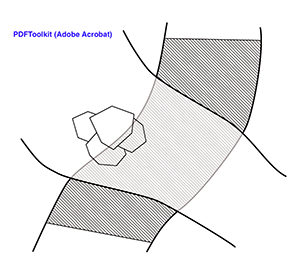
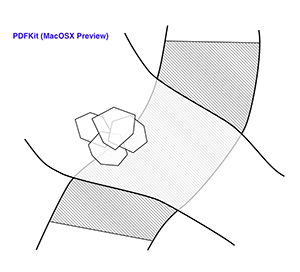
Examples of Rendering Differences Between PDF Viewers
Each of the PDF readers renders Therion generated PDFs differently. Here are some examples from Windows versions of the PDF readers.
Adobe Acrobat
Regardless of your preferred PDF viewer, you should consider that the majority of cavers who view your PDF if you are making it available as a file will be using this viewer. Rocks drawn using the rock-border line type are rendered solid (rather than semi-transparent as in other viewers), as are Therion drawn blocks. So if you draw a rock partly overlapping water or sand or other rocks then you will not see the items below the rock. You will still see details of passages below the passage your rock is in when passages overlap however. You will see the colours (assigned by Therion using the colour by altitude feature) are less bright than in the other viewers.
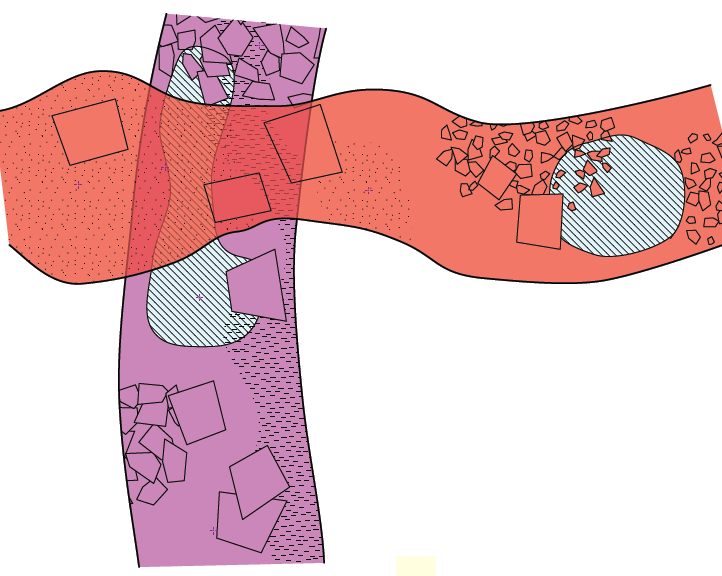
In this example survey, the upper passage contains sand fill, and the lower passage contains clay fill. Note how sand and clay fills are displayed under the water, and blocks are displayed on top of the water. Rocks in the upper passage still show the details of the lower passage below them, but do not show details of area fills in the same passage (scrap) as themselves under the rocks.
The blocks on the far right of the upper passage were drawn before the water area, and this causes the water to appear on top of them so they do not appear in the water (this water fill has a solid colour background copied from Bruce's layout examples). The blocks fill drawn after the water fills appear on top of the water (the blocks look like they stick out of the water surface).
Foxit/SumatraPDF
This screenshot is from Foxit Reader, but SumatraPDF renders exactly the same. These readers render rocks as semi-transparent. So if you do not want to see what is underneath your blocks/rocks then you need to define area fills around the rocks for these viewers. But colours are more vibrant than in Adobe Reader.

Evince
This reader does not clip area fills properly, so they extend outside walls and area borders. It appears that the clipping is done using vertical and horizontal boundaries only in this viewer.
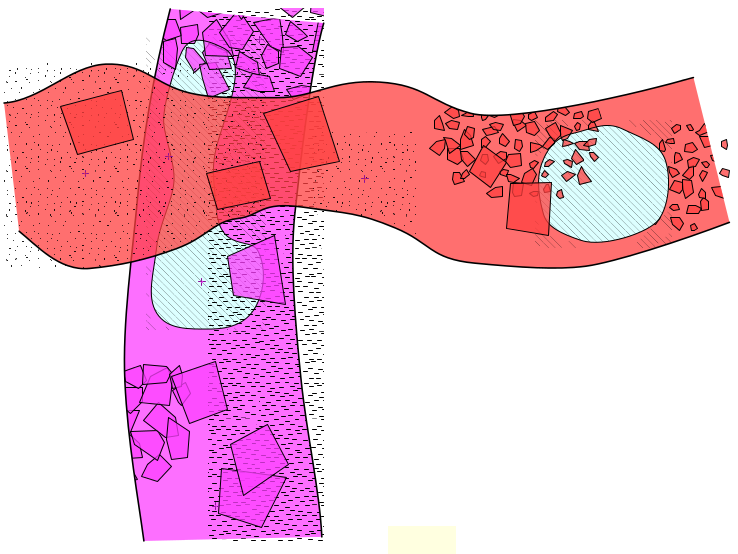
Inkscape edited PDFs
Interestingly, if you edit a PDF in Inkscape, then open the new PDF saved by Inkscape in Adobe Reader then the rendering now looks like Foxit Reader. The more vibrant colours are seen, and blocks/rocks are now semi-transparent. Unfortunately Inkscape messes up the water area fill. Something to consider if you plan to edit your PDFs outside of Therion. Inkscape itself is not able to work with areas.
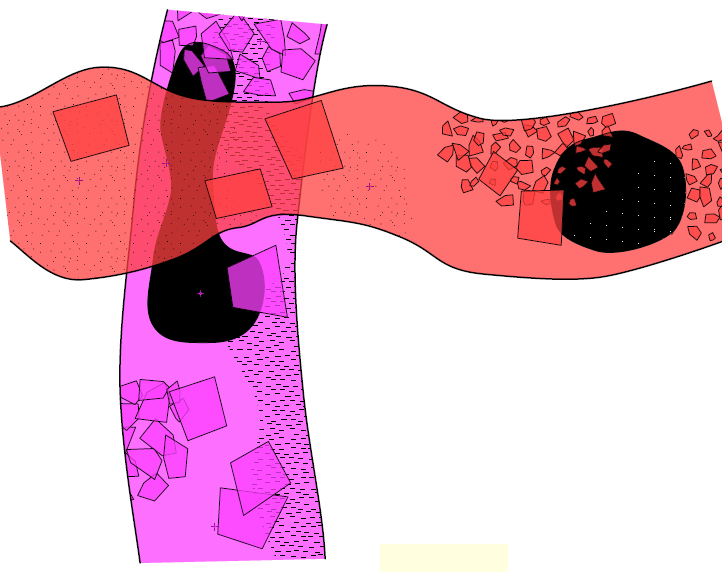
MacOSX Quick Look and Preview
Rendering looks like Foxit Reader, Quick Look (press spacebar when file highlighted) is quite fast way how to see file. Preview has some editing capabilities. In last MacOSX version (Mojave) Quick Look has editing possibility too.
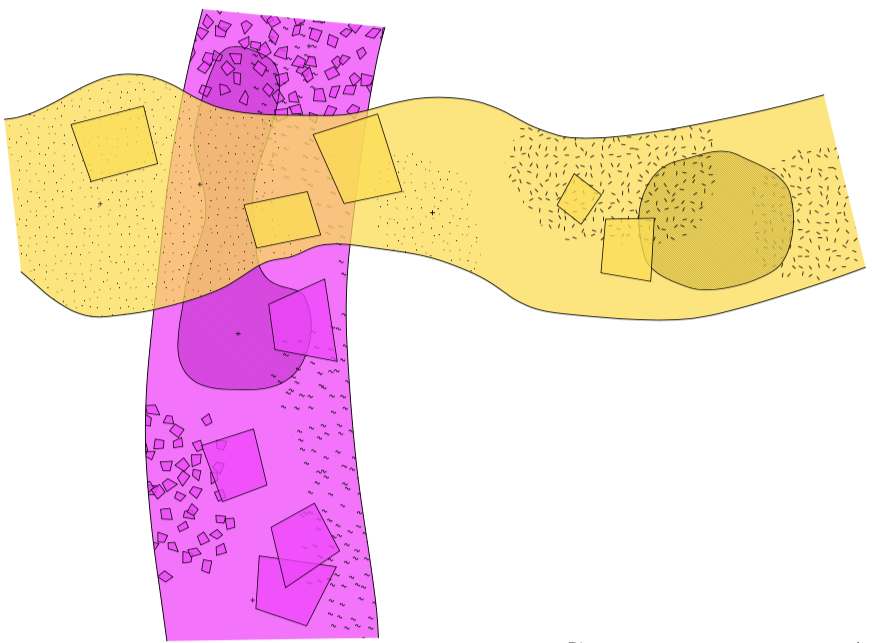
xpdf
Correct rendering of overlap objects. On MacOSX it is possible to install it by homebrew installer. xpdf should antialias vectors, but not in this case, so rendering is quite coarse. The reason is when transparency knockout is used, the antialiasing in layers is not rendered. It should be corrected in next version of xpdf - current version is 4.
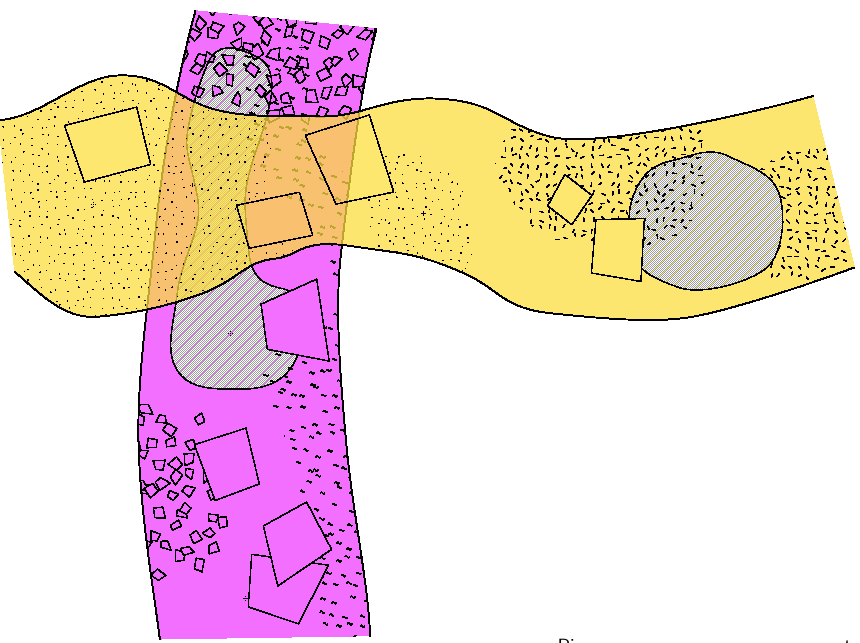
All the above PDF screenshots are using Footleg's custom symbols for UK styles. But the default Therion symbols render with the same differences. You can generate these examples with these source project files
For SVG files
For DXF files
dxfviewer http://www.escape.de/~quincunx/dxfviewer http://caff.de/dxfviewer/
Need Java runtime. Somewhat intuitive.
For SQL files
SQLite Database Browser http://sqlitebrowser.org/
Somewhat intuitive. (Remember you need to import sql files, you cannot open them)
SQlite http://www.sqlite.org/
A command line interface. Some more information on the Therion by Examples pages
Therion data Web Interface
Querying the Therion database through a web interface. See databasequery by Andrew Atkinson
OpenOffice
http://www.openoffice.org